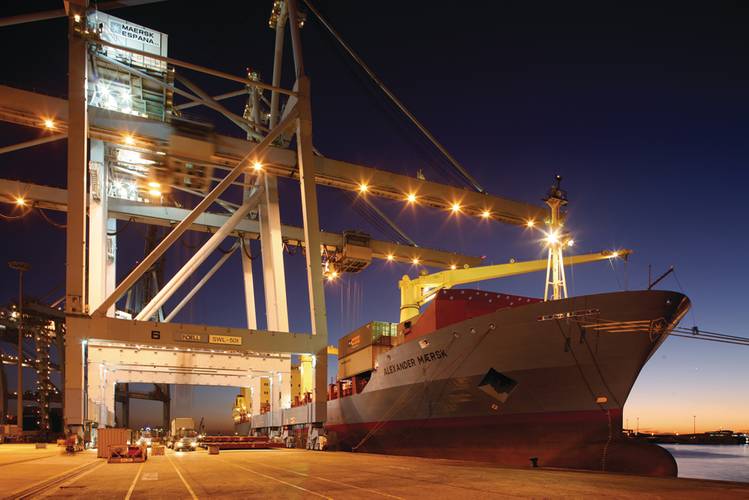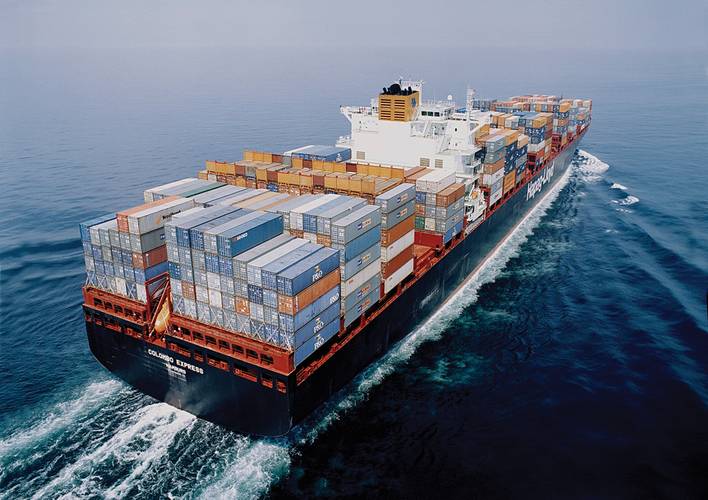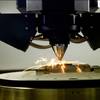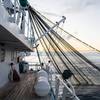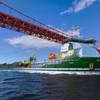MAN Diesel & Turbo and the Tier-III Age
The introduction of the electronically controlled camshaft-less low speed diesel engines (ME-range) are a milestone in diesel technology, a milestone that deserves a place in history similar to Rudolf Diesel’s first engine in Augsburg for the 1912 motor vessel Selandia, the introduction of turbocharging on two-stroke diesels in 1954, and the first SCR (Selective Catalytic NOx Reduction) systems on ships in 1989.
The IMO Tier III NOx regulations that will come into force in 2016, when operating inside an Emission Control Area (ECA), means that NOx emissions from a large two-stroke diesel engines must not exceed a cycle value of 3.4 g/kWh, and NOx emission must not exceed 5.1 g/kWh at individual load points of the load cycle (80% NOx reduction compared to the Tier I level). Although IMO recently has postponed the Tier III introductory date Ole Groene, Vice President Marketing and Sales, said, “This has no consequences for our developments. We will continue our work to ensure shipping by sea as the most environmentally friendly form of transport.”
The 80% load cycle NOx reduction requirement means that internal engine optimization is not sufficient – in other words, new technology is necessary.
The mode cap on the individual mode points of the load cycle means that the applied solutions have to suit a wide engine load range. As Tier III NOx limit only applies in emission control areas, the engine must be able to switch between Tier II and Tier III NOx levels.
Within the last two years, technologies to achieve Tier III NOx reduction have successfully been tested at MAN’s Diesel & Turbo R&D center in Copenhagen. Both EGR and SCR have been successfully tested for Tier III compliance as stand-alone NOx reduction technology.
For the company’s two-stroke marine engines, compliance will be achievable through tailored solutions. This goes for both the fuel sulfur regulation and the NOx regulation. For ships built from 2016, the operation of the main engine will be divided into two modes: operation inside and outside an ECA. This requires NOx reduction technology that can be switched on and off.
Large marine diesel engines operate on a wide range of fuel qualities, ranging from low-viscosity, ultra-low sulfur distillates to very high-viscosity residual fuels.
All MAN Diesel & Turbo Tier III engines will be capable of running on low-sulfur and, at the same time, options will be available for complying with the fuel sulphfur limits by other means, thus enabling heavy fuel oil (HFO) operation.
Selective Catalytic Reduction
A way of meeting the IMO Tier III NOx limits is to install a selective catalytic reduction (SCR) reactor. In the reactor, NOx is reduced catalytically by ammonia (as urea) and water. MDT was involved in a targeted development of this technology together with Hitachi Zosen Corporation (license of MDT).
And in late 2010, MAN Diesel & Turbo confirmed that MAN B&W 6S46MC-C8 (output of almost 7 MW) engine with integrated SCR fulfils the IMO’s strictest emission standards Tier III. This was the world’s first Tier-III-compliant 2-stroke diesel engine. The engine was bound for a general cargo carrier, to be built at the Nakai shipyard and scheduled to enter active service later that year. The vessel was ordered by Japanese customer, BOT Lease Co. Ltd., and is operated by Nissho Shipping Co. Ltd.
The first engine start took place in January 2011. A MAN Diesel & Turbo team optimized the integration of the SCR system that removes NOx from the engine’s exhaust gas.
The SCR system features:
• more than 80% NOx reduction based on the load cycle
• more than 70% NOx reduction on each load point in the load cycle
• easy switching between on/off modes for optimal emission performance on high seas and coastal waters.
“We haven’t just provided an engine and added an SCR system to it,” said Søren Jensen, VP Research & Development, Marine Low-Speed MAN Diesel & Turbo. “On the contrary, we have delivered a bespoke system. As engine designer, builder and catalyst designer, MAN Diesel & Turbo and Hitachi Zosen comprise a group of specialists that have delivered an optimized propulsion/emissions package of engine, engine-control system and SCR system.”
“In the future, MAN Diesel & Turbo wants not only to develop engines but also to design engines with complete, emission-reduction systems,” Jensen said. “To that end, we envisage collaborating with many other partners in times to come in the same successful fashion as we have seen in Japan.”
Technical Characteristics
To achieve the desired, higher exhaust-gas temperature and maximize NOx removal, the different elements of the emissions package are laid out in series, with the SCR system placed before the turbocharger. MAN Diesel & Turbo’s engine-control system has a number of different ways to ensure the correct, exhaust-gas temperature.
• EGR Application for Tier III
NOx reduction in his magnitude on two-stroke diesel engines, requires add-on technologies like Exhaust Gas Recirculation (EGR) or Selective Catalytic Reduction (SCR).
Back in 2004, MAN Diesel & Turbo started the first test program with EGR on the large 4T50ME-X two-stroke diesel test engine in Copenhagen, in order to verify the effect of EGR. The effect of EGR on smaller four-stroke diesel engines used in the automotive sector has been known since the 1970’ies as a very efficient means to reduce NOx in combustion engines.
The HFO burned in large marine engines is a challenge when using EGR, due to the presence of high sulfur content and high content of solids thus a wet scrubber was introduced in the EGR system. In parallel with the EGR investigation on the 4T50ME-X test engine, MAN Diesel & Turbo planned to make a service test on a ship in order to investigate long term effects on the engine components. In March 2010, a retrofit EGR system was installed on a 10MW 7S50MC Mk-6engine onboard A.P. Moeller Maersk 1100 TEU container vessel Alexander Maersk. The recent EGR investigation and service test is a part of the large European development project named HERCULES-B with focus on high engine efficiency and low emissions.
The principle of EGR is based on exchange of the in-cylinder oxygen (O2) with carbon dioxide (CO2) from the exhaust gas which is recirculated into the scavenge air.
The exchange of O2 with CO2 leads to a decrease of combustion speed, resulting in lower peak temperatures during combustion. Besides the exchange of O2 with CO2 results in a higher in-cylinder heat capacity of the gas, which also lowers the combustion temperature. Lower combustion temperatures and especially lower peak temperatures result in lower formation of thermal NOx during the combustion process.
“Our EGR-systems provide a high fuel flexibility, from heavy fuel towards distillates and gas; the NOX content is reduced contemporary by a partly recirculation of exhaust back into the scavenging air,” Jensen said. “This minimizes the oxygen content of the air in the combustion chamber which in turn reduces the combustion temperature and hence the NOx formation. Test at our ”Diesel Research Center” here in Copenhagen have shown, that with the help of the EGR technic, the upcoming Tier III NOx limits are fulfilled. In the field of the ”big-bore” engines we work as well on SCR solutions; together with one of our licensees we recently put the first IMO Tier III unit in operation. In addition to this we feature also a very remarkable portfolio of gas-engines. In the business unit Low Speed we introduced the so called ME-GI engine. The ME-GI engine represents the culmination of many years’ work that began in the 1990s with the company’s prototype MC-GI dual-fuel engine that entered service at a power plant in Chiba, near Tokyo, Japan in 1994.
Depending on relative price and availability, as well as environmental considerations, the ME-GI engine gives shipowners and operators the option of using either HFO or gas – predominantly natural gas”.
More than 98% of the ships worldwide (of more than 2,000 dwt) are powered by diesel engines today. Slow-speed two-stroke engines as the main propulsion account for 75% of the total installed output and hereof around 80% are of MAN Diesel & Turbo make. The diesel engine, with efficiency as high as 52%, is the most economical mode of ship propulsion.
The biggest diesel engines currently installed in ships are 14-cylinder, two-stroke engines whose output of more than 80,000 kW, is about 6,000 times higher than that of the first diesel engine of 1897. The recent developments described above impressively show that the diesel engine still has considerable potential; the limits of design development are far from foreseeable. The use of LNG in dual-fuel engines, in particular, is expected to play an increasingly important role in the industry. With regard to the upcoming IMO regulations – above all the global target of a 0.5% cap on SOx emissions from 2020 on – the days of heavy fuel oil, once so very important in shipping, could be numbered.
Diesel engine makers are preparing intelligent solutions for these challenges. It will still take quite some time before alternative kinds of ship propulsion have been sufficiently developed to offer an economically viable alternative to diesel engines.
In Fact
The biggest diesel engines currently installed in ships are 14-cylinder, two-stroke engines whose output of more than 80,000 kW, is about 6,000 times higher than that of the first diesel engine of 1897.
(As published in the September 2013 edition of Maritime Reporter & Engineering News - www.marinelink.com)






